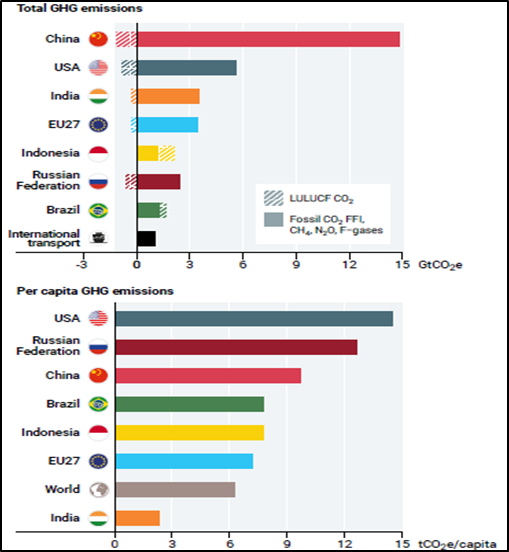In News:
- The United Nations Environment Programme (UNEP) recently released the Emissions Gap Report 2022, ahead of the United Nations Climate Change Conference (COP27) in Sharm El Sheikh, Egypt.
- The report stated that the world is falling short of the goals set out in the 2015 Paris Climate Agreement, and that emissions have rebounded and increased in India and six other major emitters following the pandemic.
What’s in today’s article:
- About the UNEP
- About the Emission Gap Report
About the United Nations Environment Programme (UNEP):
- It was established after the United Nations Conference on the Human Environment in Stockholm in 1972 and is headquartered at Nairobi, Kenya.
- The UNEP is responsible for coordinating responses to environmental issues within the United Nations system.
- It does so through the UN Environment Assembly, the world’s highest decision-making body on the environment
- The organisation -
- Develops international environmental agreements, publishes and promotes environmental science and helps national governments achieve environmental targets.
- Through its campaigns, particularly World Environment Day (June 5), UNEP raises awareness and advocates for effective environmental action.
- As a member of the United Nations Development Group, UNEP aims to help the world meet the 17 Sustainable Development Goals (SDG).
- Hosts the secretariats of several multilateral environmental agreements and research bodies, including -
- The Convention on Biological Diversity (CBD),
- The Minamata Convention on Mercury,
- The Convention on Migratory Species and
- The Convention on International Trade in Endangered Species of Wild Fauna and Flora (CITES).
- Is also one of several Implementing Agencies for the Global Environment Facility (GEF) and the Multilateral Fund for the Implementation of the Montreal Protocol.
- In 1988, the World Meteorological Organization (WMO) and UNEP established the Intergovernmental Panel on Climate Change (IPCC).
- It also publishes an annual Emissions Gap Report.
The Emission Gap Report:
About:
- UNEP Copenhagen Climate Centre (UNEP CCC) has managed the production of UNEP’s flagship report on climate change - the Emissions Gap Report - since 2011.
- The report is an annual science-based assessment of the gap between countries’ pledges on greenhouse gas (GHG) emissions reductions and the reductions required to deliver a global temperature increase of below 2°C by the end of this century.
- Each year the reports also feature assessment of key opportunities for bridging the gap.
- The recently released 2022 report (titled - 'Emissions Gap Report 2022: The Closing Window - Climate Crisis Calls for Rapid Transformation of Societies') is the 13th edition of the report.
Highlights of the Emissions Gap Report 2022:

- The top 7 emitters plus international transport accounted for 55% of global GHG emissions in 2020.
- Collectively, G20 members are responsible for 75% of global GHG emissions.
- The global average per capita GHG emissions was 6.3 tonnes of CO2 equivalent (tCO2e) in 2020. India remains far below the world average at 2.4 tCO2e.
- The report finds that the international community is falling far short of the Paris goals, with no credible pathway to 1.5°C in place.
- The Paris Agreement defined a global warming limit of 2°C above pre-industrial levels (preferably 1.5°C), which if exceeded, can result in extreme weather events such as extreme heat waves, droughts, water stress, etc.
- The report shows that updated national pledges since COP26 (held in 2021 in Glasgow, UK) make a negligible difference to predicted 2030 emissions.
- For most major emitters, GHG emissions (excluding land use and forestry sectors) rebounded in 2021, exceeding pre-pandemic 2019 levels.
- According to the report, the world needs to reduce GHGs by unprecedented levels over the next eight years, so global warming will not surpass the threshold.
- Only an urgent system-wide transformation can deliver the enormous cuts needed to limit GHG emissions by 2030.
- Unconditional and conditional Nationally Determined Contributions (NDCs) are expected to reduce global emissions by 5% and 10%, respectively, by 2030, when compared to current policies.
- To be on the most cost-effective path to limiting global warming to 2°C or 1.5°C, these percentages must reach 30% and 45%,
Significance of the report:
- It emphasises the lack of credible roadmaps that can guide countries from actions planned for this decade to actions required by the middle of the century.
- It also emphasises the need for a 10-fold increase in funding and the need for alternative technologies in heavy-industry to reverse the rise in carbon intensity of global steel production.
- It is encouraging to see that India has maintained its momentum in renewables However, to meet its targets, it will need to increase its reliance on non-fossil energy.










